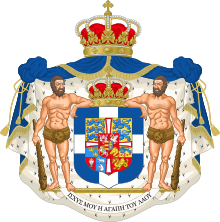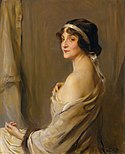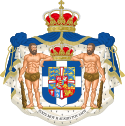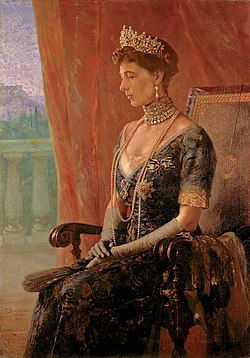Seznam řeckých princezen sňatkem

Toto je seznam řeckých princezen, které titul získaly sňatkem, od nastoupení Geórgia I. na trůn Řeckého království v roce 1863. Ženy držící titul princezny jsou obvykle oslovovány jako „Její královská Výsost“ (JkV).
Alžběta II., Marína Kárella a Irina Alexandrovna Ovtčinniková, přestože splňují většinu požadavků, nejsou klasifikované jako řecké princezny, protože princ Fílippos, manžel Alžběty II., se vzdal svých řeckých (a dánských) titulů, princ Michaíll měl morganatický sňatek a princ Pétros po svatbě ztratil svá nástupnická práva.
Seznam řeckých princezen sňatkem od roku 1863
| Portrét | Jméno | Řecké jméno | Narození | Smrt | Sňatek | Manžel |
|---|---|---|---|---|---|---|
 | Princezna Sofie Pruská | Sofía | 1870 | 1932 | 27. října 1889 | Korunní princ Konstantin |
 | Princezna Marie Bonaparte | María | 1882 | 1962 | 21. listopadu 1907 | Princ Jiří |
 | Velkovévodkyně Jelena Vladimirovna Ruská | Eléni | 1882 | 1957 | 29. srpna 1902 | Princ Mikuláš |
 | Princezna Alice z Battenbergu | Alíki | 1885 | 1969 | 6. října 1903 | Princ Ondřej |
 | Nancy Stewart | Anastasía | 1873 | 1923 | 1. února 1923 | Princ Kryštof |
 | Princezna Františka Orleánská | Frankíski | 1902 | 1953 | 11. února 1929 | Princ Kryštof |
 | Princezna Alžběta Rumunská | Elisávet | 1894 | 1956 | 27. února 1921 rozvod 1935 | Korunní princ Jiří |
 | Aspasía Mánou | Aspasía | 1896 | 1972 | 4. listopadu 1919 | Král Alexandr |
 | Princezna Frederika Hannoverská | Freideríki | 1917 | 1981 | 9. ledna 1938 | Dědičný princ Pavel |
 | Marie-Chantal Miller | María | 1968 | 1. července 1995 | Korunní princ Pavel | |
| Tatiana Blatnik | Tatiána | 1980 | 25. srpna 2010 rozvod 2024 | Princ Mikuláš | ||
| Nina Flohr | Nína | 1987 | 12. prosince 2020 | Princ Filip | ||
| Chrysí Vardinogiánni | Chrysí | 1981 | 7. února 2025 | Princ Mikuláš |
Odkazy
Reference
V tomto článku byl použit překlad textu z článku List of princesses of Greece by marriage na anglické Wikipedii.
Související články
- Řecká monarchie
- Seznam dánských princezen sňatkem
- Seznam řeckých princezen
Média použitá na této stránce
Coat of arms of the Kingdom of Greece in 1936–1973
- Royal Coat of Arms of Greece under the Glücksburg dynasty, created after the restoration of King George II to the throne in 1935, to the exile of King Constantine II in 1967 and finally until the abolition of the monarchy in 1973.
- The Escutcheon features the white cross on a dark blue field of Greece. The Inescutcheon features the Arms of the Greek line of the House of Schleswig-Holstein-Sonderburg-Glücksburg. The shield is then topped with a golden Royal Crown.
- It features an escutcheon divided by the red and white cross of the Order of the Danneborg, the first quarter features the arms of Denmark (three crowned blue lions and nine hearts in yellow field). The second of Schleswig (two blue lions passant in yellow field). The third divided into four; the chief features the three royal crowns in blue field of the Kalmar Union, the second half with a crowned stockfish on red field of Iceland and the last half divided between the ram of the Faroe Islands and a polar bear of Greenland, both on blue fields. The fourth quarter is divided between two halves, the chief depicts a yellow field with a blue lion passant over nine red hearts of the King of the Goths, the lower half depicts a crowned golden lindorm on a red field of the King of the Wends.
- Upon it is another inescutcheon in red, divided into four quarters: the first a a silver nettle leaf of Holstein, the second the a swan with a golden crown of Stormarn, the third a knight dressed in golden armor on a silver horse of Dithmarschen and the fourth of a golden horse's head of Lauenburg.
- Upon it is another inescutcheon divided the first features the red and yellow bars of Oldenburg, the second a golden cross on a blue field of Delmenhorst.
- The escutcheon rests on a golden pedestal and supported by two human figures representing the Greek mythological hero Herakles (Heracles), holding a wooden club and wearing the skin of the Nemean lion.
- The escutcheon is surrounded by the ribbon and cross of the Order of the Redeemer, the cross depicts Christ Pantocrator, surrounded by the order's motto:"Η ΔΕΞΙΑ ΣΟΥ ΧΕΙΡ, ΚΥΡΙΕ, ΔΕΔΟΞΑΣΤΑΙ ΕΝ ΙΣΧΥΙ" or "Thy right hand, O Lord, is become glorious in power" from Exodus, 15:6.
- The motto of the Coat of arms and of the dynasty, depicted on a golden ribbon below the pedestal reads: "Ἰσχύς μου ἡ ἀγάπη τοῦ λαοῦ" or "The people's love, my strength"
- The coat of arms is then surrounded by a dark blue mantle and topped with another royal crown.
Portrait of Anastasia of Greece and Denmark, née Nancy Stewart
Autor: Frankie Fouganthin, Licence: CC BY-SA 3.0
Marie-Chantal, Crown Princess of Greece, on her way to the castle church at the Royal Palace in Stockholm for the wedding between Princess Madeleine and Christopher O'Neill, June 8, 2013.
Portrait of Princess George of Greece and Denmark, née Princess Marie Bonaparte
Aspasia Manos, consorte del Rey Alexander I de Grecia, ca. 1926.
Autor: Tento vektorový obrázek byl vytvořen programem Inkscape ., Licence: CC BY-SA 3.0
An accurate version of Greek royal Coat of Arms.
Princess Nicholas of Greece and Denmark, née Grand Duchess Elena Vladimirovna of Russia
Portrait of Elisabeta, Queen of the Hellenes, née Princess Elisabeta of Romania
Princess Frederica of Hanover, later Queen of Greece. (Prinzessin Friederike von Hannover, später Königin der Hellenen)











